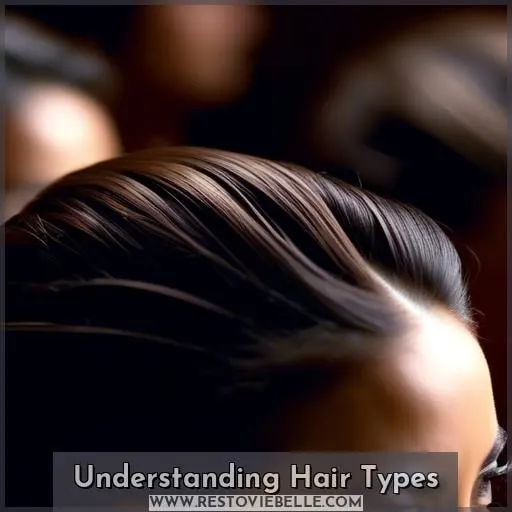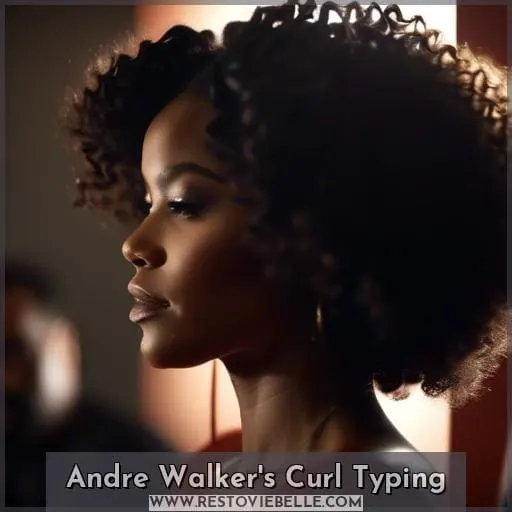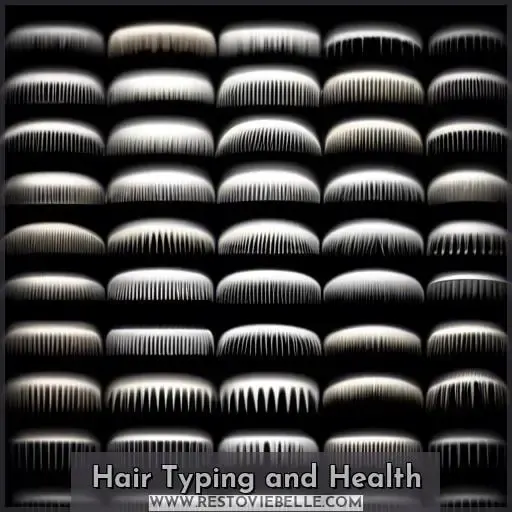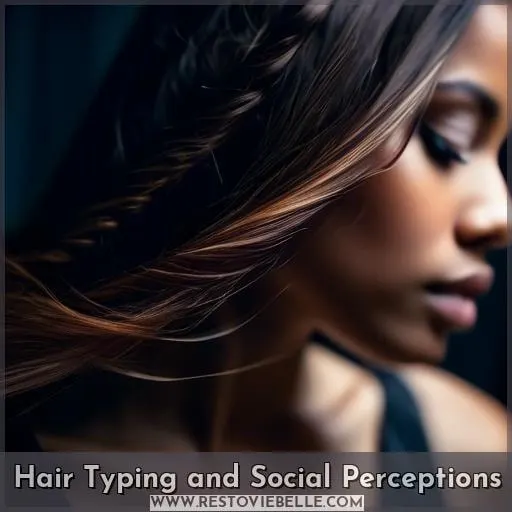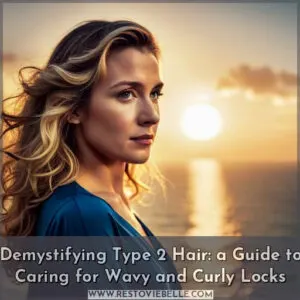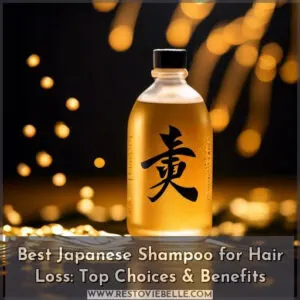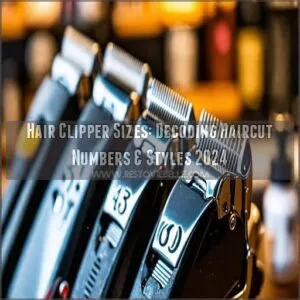This site is supported by our readers. We may earn a commission, at no cost to you, if you purchase through links.
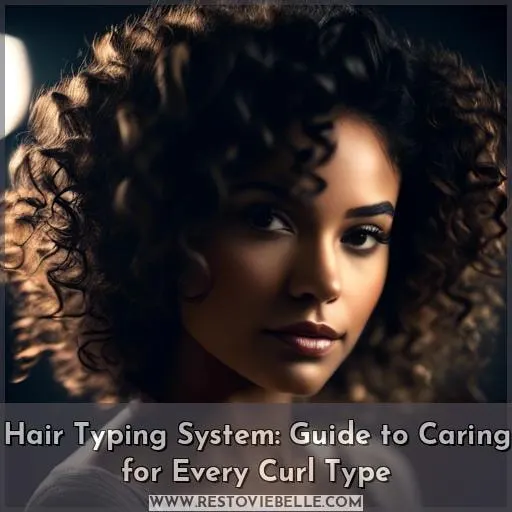 Imagine you’re eyeing a spectrum of curls, from the gentle waves to the tightest coils, each unique and requiring distinct care.
Imagine you’re eyeing a spectrum of curls, from the gentle waves to the tightest coils, each unique and requiring distinct care.
Your hair’s identity holds the key to its health and beauty. The hair typing system, a method to classify the diverse world of curls, empowers you to unlock the secrets of your strands.
Dive into this guide to understand and embrace every curl type, ensuring your hair not only survives but thrives.
Table Of Contents
- Key Takeaways
- Understanding Hair Types
- Andre Walker’s Curl Typing
- The L.O.I.S Typing System
- Hair Typing and Health
- Hair Typing and Social Perceptions
- Frequently Asked Questions (FAQs)
- How does hair typing account for mixed textures within a single head of hair?
- Can hair typing be accurately determined for chemically treated or heat-damaged hair?
- How does age or hormonal changes affect one’s hair type over time?
- Is there a way to measure hair porosity and elasticity at home to complement hair typing?
- How do environmental factors such as climate and water quality influence hair type classification?
- Conclusion
Key Takeaways
- Hair typing systems, such as the Andre Walker Hair Typing System, categorize hair into four main types (straight, wavy, curly, kinky) with subcategories to further distinguish textures, aiding in the selection of suitable products and care routines.
- Understanding hair porosity and elasticity is crucial for tailored hair care, as they affect moisture retention, hair strength, and the prevention of breakage, leading to healthier hair growth.
- The Andre Walker Hair Typing System, created by the stylist known for his work with Oprah Winfrey, is a widely recognized method for classifying hair textures and has been influential in the beauty space.
- While hair typing provides a framework for discussing and understanding hair, it is important to recognize individual variations within each hair type category and adapt hair care practices accordingly.
Understanding Hair Types
Understanding your hair type is essential for maintaining its health and choosing the right care products. Hair texture and porosity are key factors that influence how your hair retains moisture and responds to hair care treatments.
Recognizing whether you have fine, medium, or thick hair, along with your hair’s ability to absorb and retain moisture, can guide you in selecting products and styling methods that will work best for your unique hair characteristics.
Significance for Hair Care
Understanding your hair type is more than just a step towards great hair days; it’s a journey to healthier, happier hair.
- Product Selection: Knowing your hair type—be it straight, wavy, curly, or coily—guides you in choosing products that cater specifically to your hair’s needs, preventing damage and promoting health.
- Customized Care: Each hair type responds differently to treatments and styling. By understanding your type, you can tailor your hair care routine to enhance your hair’s natural beauty.
- Understanding Porosity: Hair porosity affects how well your hair absorbs and retains moisture. Recognizing your hair’s porosity can help you select hydrating products that keep your hair nourished and resilient.
- Elasticity Insights: Elasticity determines how your hair bounces back after being stretched. Knowing this can help you avoid breakage and choose styling practices that maintain your hair’s integrity.
By embracing your unique hair type, you’re not just following a trend; you’re committing to the health and vitality of your hair, ensuring it looks and feels its best every day.
Hair Texture and Porosity
Understanding your hair’s texture and porosity is pivotal for tailoring your hair care routine to meet its unique needs. Hair texture ranges from thin to thick, influencing how products sit and absorb into your hair.
Porosity, on the other hand, determines your hair’s ability to absorb and retain moisture, significantly affecting its health and styling.
| Characteristic | Impact on Hair | Emotional Connection |
|---|---|---|
| Hair Texture | Determines the weight and volume of hair, affecting styling and product choice. | Connects to personal identity and how one is perceived. |
| Hair Porosity | Influences moisture retention, crucial for hair’s vitality and strength. | Ties to the struggle and triumph in achieving healthy, vibrant hair. |
| Strand Pattern | Shapes the hair’s overall appearance, from straight to coily. | Reflects the uniqueness of each individual, celebrating diversity. |
By understanding these aspects, you’re not just caring for your hair; you’re embracing your identity and the journey towards healthier, more vibrant hair. Whether dealing with frizziness, selecting products, or determining the best care practices, recognizing your hair’s texture and porosity is a step towards mastering its care and celebrating its natural beauty.
Andre Walker’s Curl Typing
Andre Walker’s Curl Typing System, introduced in the 1990s, offers a comprehensive method to classify hair textures into four main categories: straight, wavy, curly, and coily. This system provides further distinctions within each category through subcategories a, b, and c.
Understanding your hair’s unique characteristics through this system can help you select the most suitable products and care routines to enhance your hair’s health and appearance. By recognizing your specific hair type, you can better address its needs, leading to more effective and personalized hair care strategies.
Four Main Categories
Diving into the world of hair care, it’s essential to grasp the nuances of Andre Walker’s Curl Typing System, a cornerstone for understanding your hair’s unique needs.
This system breaks down hair into four primary categories: straight, wavy, curly, and coily, each with subcategories (a, b, c) to fine-tune your hair’s specific type. Knowing whether you have 1A straight hair or 4C coily hair can significantly influence your hair care routine, from the products you choose to the styling techniques you employ.
For instance, straight hair might seek sheen and frizz control, while coily textures prioritize moisture retention and gentle handling to prevent breakage. This system’s historical evolution, from its inception to its role in today’s hair care practices, underscores the importance of recognizing and celebrating the diversity of hair textures.
By understanding your hair type, you’re better equipped to select products and styling methods that enhance your hair’s natural beauty, whether that involves embracing your curls with the right moisture-rich products or mastering frizz control techniques for a sleek finish.
Subcategories and Characteristics
Understanding your curl pattern, hair density, and growth patterns is key to optimizing your hair care routine. Andre Walker’s hair typing system breaks down these characteristics into subcategories, providing a detailed map for your hair’s needs.
Type 1 hair ranges from pin-straight (1A) to thick (1C), with oil traveling easily down the shaft, enhancing shine. Wavy hair, Type 2, spans from slight bends (2A) to defined S-waves (2C), often grappling with frizziness.
Curly hair, Type 3, includes looser (3A) to tighter curls (3B), prone to dryness and loss of definition. The coiliest category, Type 4, features tight spirals (4A) to less defined Z-patterns (4B), with both susceptible to hair shrinkage and brittleness.
Knowing your type aids in selecting styling techniques and products, predicting chemical reactions, and maintaining hair health.
The L.O.I.S Typing System
The L.O.I.S Hair Typing System offers a unique approach to classifying hair beyond the commonly known numerical categories.
This system aids in identifying the right care and products for your hair, enhancing its health and appearance.
Strand Pattern Classification
When exploring the L.O.I.S Typing System, you’ll find it’s a nuanced approach to understanding your hair’s unique characteristics.
Strand shape is key, with L representing bends with little curve, O for strands that form tight circles, I for straight hair, and S for curls resembling the letter.
Strand thickness matters too; compare your hair to a thread to determine if it’s fine, medium, or coarse.
This system aids in product selection, ensuring you choose items that cater to your hair’s specific needs, whether you have wavy, curly, coily, or kinky hair.
It’s not just about curl definition; it’s also about managing frizz and selecting products that enhance your hair’s natural beauty.
Strand Size and Texture
Understanding your hair’s unique characteristics is essential for maintaining its health and selecting the right products. The LOIS Hair Typing System offers a nuanced approach to categorizing hair beyond simple curl patterns.
It considers strand texture, hair thickness, and other factors that influence hair health.
When using the LOIS system, you’ll assess:
- Strand Texture: Compare a strand of your hair to a piece of thread. If it’s thinner, your hair is fine; if thicker, it’s coarse. Medium strands match the thread’s diameter.
- Hair Thickness: This refers to the density of hair strands on your scalp. It’s a measure of how much hair you have rather than how thick each strand is.
- Density Porosity: This is your hair’s ability to absorb and retain moisture, which affects how products interact with your hair.
For those with afro-textured hair, understanding these aspects can be particularly beneficial. The right hair products for your texture, thickness, and porosity can promote hair health and ease styling.
Remember, hair care isn’t one-size-fits-all; it’s about finding what works for your unique hair type.
Hair Typing and Health
Understanding your hair’s porosity and elasticity is key to tailoring a hair care routine that keeps your locks healthy and vibrant.
Porosity refers to your hair’s ability to absorb and retain moisture, which affects how well products and treatments work for you.
Elasticity, on the other hand, indicates the strength and flexibility of your hair, which is crucial for preventing breakage and maintaining hair integrity.
Porosity and Elasticity
Understanding your hair’s porosity and elasticity is key to maintaining its health and vitality. Porosity refers to your hair’s ability to absorb and retain moisture, which is crucial for preventing hair damage and ensuring proper moisture retention.
High porosity hair may absorb moisture quickly but also lose it just as fast, leading to dryness and breakage. Conversely, low porosity hair struggles to absorb moisture, which can leave it looking dull and make hair care products less effective.
Elasticity, on the other hand, is about your hair’s flexibility. Healthy hair with good elasticity can stretch and bounce back without breaking, allowing for more resilience during hair styling and less breakage.
This characteristic is essential for hair growth and maintaining hair density, as it reduces the likelihood of hair damage from daily wear and tear.
Whether you have straight hair or tightly coiled curls, understanding these properties can guide you in choosing the right hair care products and styling methods that cater to your hair’s unique needs.
By nurturing your hair’s porosity and elasticity, you’re setting the stage for stronger, healthier hair growth.
Hair Care Customization
Understanding your hair’s unique needs is key to crafting a personalized care routine that promotes health and showcases your natural beauty. After delving into porosity and elasticity, it’s clear that no one-size-fits-all solution exists for hair care.
Your journey with Andre Walker’s Curl Typing System or any other method should guide you towards product selection that aligns with your hair’s characteristics, from curl enhancement to moisture retention.
Selecting the right products—those that cater specifically to your hair type, whether it’s maintaining scalp care for type 1A or boosting hydration in 4C coils—can transform your hair routines into a nurturing ritual that respects your hair’s natural texture and needs.
Embrace this knowledge to explore hair care options that not only prevent damage but also elevate your hair’s health and appearance. Remember, understanding your hair type isn’t just about managing your strands; it’s about celebrating and caring for them in a way that feels both personal and empowering.
Hair Typing and Social Perceptions
Understanding your hair type is more than a cosmetic concern; it’s a crucial aspect of maintaining hair health and embracing one’s identity.
Historically, hair typing has been used to enforce racial discrimination, with systems like the apartheid pencil test categorizing individuals based on hair texture. Today, while hair typing helps predict how hair responds to styling and products, it also perpetuates texturism, a form of discrimination against coarser, Afro-textured hair.
This bias has real-world consequences, affecting individuals in schools and workplaces, and challenges the notion that all hair textures are equally worthy of praise. Embracing natural hair, regardless of its type, is a step toward dismantling these outdated perceptions and celebrating diversity.
Historical Context
Understanding your hair type isn’t just about aesthetics; it’s about health. Knowing whether your hair is straight, wavy, curly, or coily can guide you to the right care and products, ensuring your hair remains healthy and vibrant.
- Eugen Fischer’s hair gauge, used in the early 1900s, was a tool for measuring whiteness in Namibia, contributing to a legacy of racial discrimination.
- The Apartheid Pencil Test in South Africa classified individuals by hair texture, reinforcing racial hierarchies and impacting social perceptions.
- Texturism, or discrimination based on hair texture, continues to affect individuals like Blue Ivy Carter, highlighting the need to embrace and celebrate natural hair.
This historical context underscores the importance of recognizing and challenging the biases that have been associated with hair types. Embracing natural hair in all its forms is a step towards dismantling these outdated and harmful standards.
Texturism and Discrimination
As we delve deeper into the nuances of hair typing and its social implications, it’s crucial to confront the pervasive issue of texturism and discrimination. This form of bias not only affects personal self-esteem but also perpetuates cultural biases, underscoring the importance of representation and self-acceptance.
| Aspect | Impact |
|---|---|
| Social Impact | Texturism reinforces societal preferences, affecting self-esteem and social interactions. |
| Cultural Bias | Promotes a narrow beauty standard, marginalizing diverse hair textures. |
| Representation | Lack of diverse representation in media and products perpetuates exclusion. |
| Intersectionality | Texturism intersects with racism, affecting individuals differently based on their racial and ethnic backgrounds. |
| Self-Acceptance | Encouraging self-acceptance is vital for combating internalized biases. |
Understanding and addressing texturism isn’t just about hair; it’s about dismantling systems of discrimination and embracing the diversity of our natural beauty. Representation matters, and by fostering a culture of acceptance and appreciation for all hair types, we can move towards a more inclusive society.
Embracing Natural Hair
Continuing from the discussion on texturism and discrimination, it’s essential to recognize the shift towards hair acceptance and the celebration of natural beauty.
Embracing your natural hair is a profound act of self-love and texture appreciation. It’s a journey that not only reflects cultural diversity but also fosters a sense of belonging.
By valuing every coil and kink, you’re not just nurturing your hair; you’re affirming your identity and the rich tapestry of human expression.
Frequently Asked Questions (FAQs)
How does hair typing account for mixed textures within a single head of hair?
Hair typing doesn’t perfectly account for mixed textures; you may have different curl patterns on one head.
Can hair typing be accurately determined for chemically treated or heat-damaged hair?
Chemically treated or heat-damaged hair may alter its texture, making accurate hair typing challenging.
It’s best to assess your hair’s current state, considering damage, to determine its needs.
How does age or hormonal changes affect one’s hair type over time?
As you age, hormonal fluctuations can alter your hair’s texture, thickness, and growth patterns.
Is there a way to measure hair porosity and elasticity at home to complement hair typing?
To measure hair porosity at home, perform the glass of water test: drop a clean hair strand into a glass of water and observe if it floats (low porosity) or sinks (high porosity).
For elasticity, gently stretch a wet hair strand and release; if it returns to its original length without breaking, elasticity is good.
How do environmental factors such as climate and water quality influence hair type classification?
Climate and water quality significantly impact hair, affecting its texture, moisture level, and health.
Humid climates may lead to frizzier or curlier hair, while dry climates can cause hair to become brittle.
Sun exposure damages hair cuticles, leading to dryness and breakage, and pollution contributes to hair damage and scalp sensitivity.
Conclusion
Navigating the world of curls with the hair typing system is akin to unlocking a treasure chest of self-care secrets.
It’s not just about categorizing your curls; it’s about understanding the unique needs of your hair, from the gentle waves to the tightest coils.
This journey of discovery empowers you to tailor your hair care routine, ensuring your locks aren’t only nurtured but flourish in their natural beauty.
Embrace your hair’s individuality, and let the hair typing system guide you to a regimen that celebrates and enhances your natural curls.

